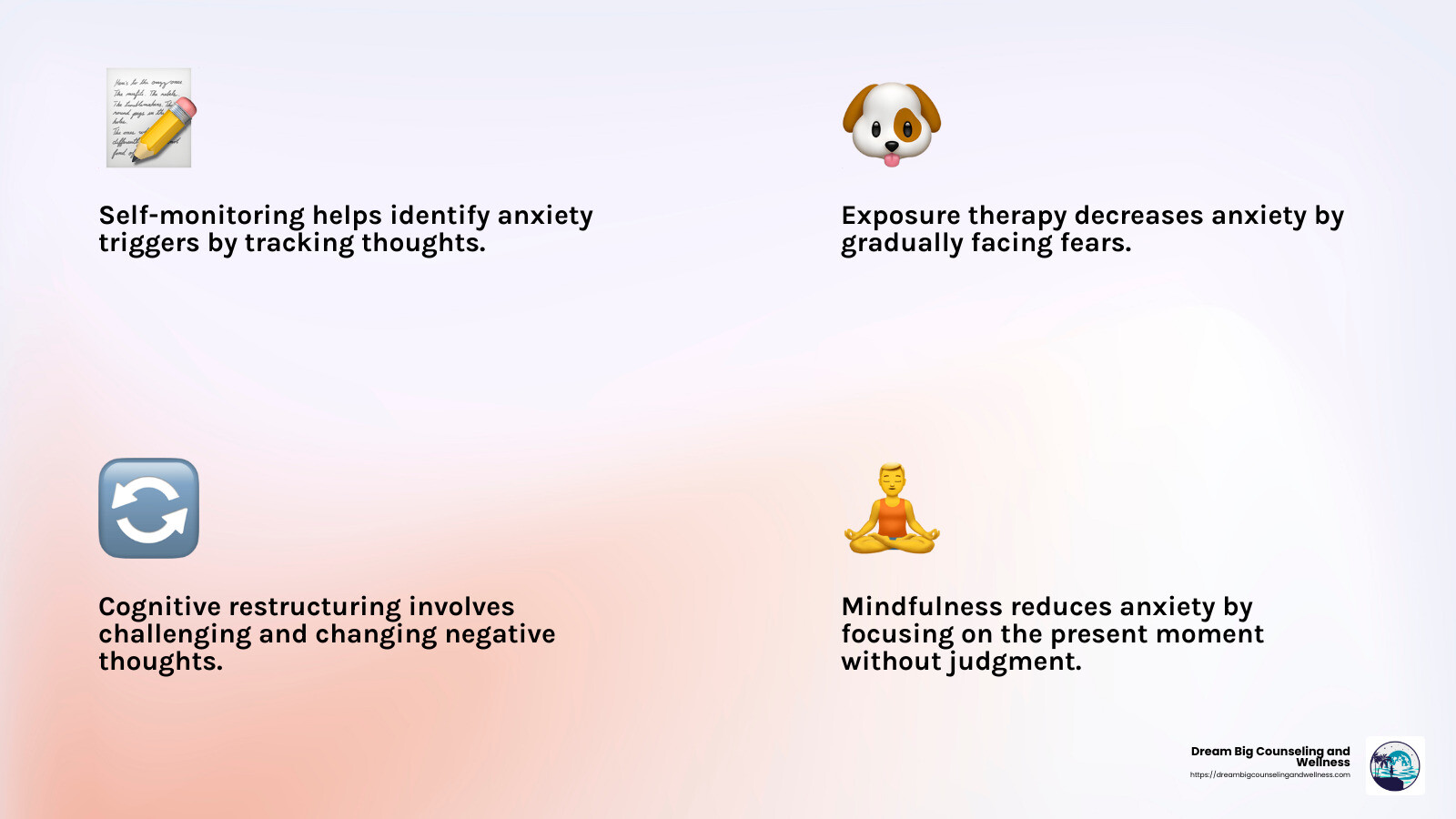Cognitive therapy for anxiety offers a powerful pathway towards managing overwhelming emotions and thoughts. By focusing on changing negative thinking patterns, this approach aims to alleviate the symptoms of anxiety and improve mental well-being.
Here’s a quick glance:
- What it does: Helps change negative thinking patterns.
- Why it matters: Reduces anxiety symptoms and improves quality of life.
- How it works: Focuses on thoughts and behaviors to alter emotional responses.
- Who it helps: Anyone looking to manage anxiety and improve mental health.
When anxiety disorders are increasingly common, cognitive behavioral therapy (CBT) stands out as an effective solution. This therapeutic approach focuses on modifying harmful thoughts, which can lead to improved emotional and psychological health. CBT combines both cognitive and behavioral techniques to shift how we react to stressors, helping manage conditions like generalized anxiety disorder, social anxiety, and specific phobias.
CBT is not just about addressing symptoms; it embodies a holistic form of healing that aims to improve quality of life. By working with a therapist, individuals can develop healthier coping strategies, reduce distress, and live more balanced lives. For a more detailed understanding, read on to see how cognitive therapy might fit into your personal journey towards mental wellness.
Understanding Cognitive Therapy for Anxiety
Cognitive Behavioral Therapy (CBT) is a structured form of therapy aimed at tackling anxiety by changing how we think. It’s like rewiring your brain to handle stress better.
Principles of CBT
CBT is built on a simple idea: our thoughts, feelings, and behaviors are all connected. By changing negative thought patterns, we can alter how we feel and act. This therapy doesn’t just treat symptoms; it helps you understand the root cause of your anxiety.
Dr. Steven Lucero, a clinical psychologist, says, “CBT helps individuals identify the links in the chain that lead to worse anxiety and depression: the thoughts, feelings, behaviors, and physical sensations that are intimately connected to one another.”
Negative Thought Patterns
Anxiety often stems from negative thinking. You might overgeneralize, assume the worst, or focus too much on small details. These thoughts can become a self-fulfilling prophecy, making anxiety worse.
CBT helps you recognize these patterns and teaches you how to reframe them. Instead of thinking, “I’ll never succeed,” you learn to think, “I can try my best and see what happens.”
Structured Therapy
CBT is highly structured. It usually involves a set number of sessions where you work with a therapist to tackle specific issues. You might start by identifying negative thoughts and then gradually work on changing them.
One technique used in CBT is cognitive restructuring, where you challenge your negative thoughts and replace them with more positive and realistic ones. Another technique is thought challenging, which involves looking at things from different angles and using evidence to support or refute your thoughts.
Why It Works
CBT’s structured approach makes it effective. By focusing on specific goals and using proven techniques, CBT helps people manage their anxiety better. It’s about taking action and facing the situations that trigger anxiety, rather than avoiding them.
Therapist Ciara Jenkins explains, “When you can create space between a situation and your thoughts, feelings, and actions, it gives you the power to handle the situation.”
CBT isn’t just about feeling better in the short term; it’s about building skills that last a lifetime. By learning to think differently, you can change how you feel and act, leading to a more fulfilling life.
In the next section, we’ll dive into the key techniques used in cognitive therapy and how they can help you on your journey to managing anxiety.
Key Techniques in Cognitive Therapy
Cognitive therapy for anxiety uses several key techniques to help you manage and reduce anxiety. These techniques are practical tools that you can use in everyday life to change how you think and feel.
Self-Monitoring
Self-monitoring is like keeping a diary of your thoughts and feelings. You write down when you feel anxious and what you were thinking at the time. This helps you spot patterns and triggers for your anxiety.
- Why it works: By understanding what triggers your anxiety, you can start to change how you react. It’s about gaining insight into your own mind.
Exposure Therapy
Exposure therapy is all about facing your fears in a safe and structured way. You start with something that causes a little anxiety and gradually move to bigger challenges.
-
How it works: Imagine you’re scared of dogs. You might start by looking at pictures of dogs, then watching videos, and eventually, you might visit a park with dogs. Over time, your anxiety decreases.
-
Why it’s effective: By facing your fears, you learn that the things you fear are not as scary as they seem. This reduces your anxiety over time.
Cognitive Restructuring
Cognitive restructuring involves changing the way you think about things. Instead of thinking, “I’m going to fail,” you learn to think, “I can try my best.”
-
How it works: You challenge negative thoughts and replace them with more balanced ones. It’s like retraining your brain to think more positively.
-
Benefit: This technique helps break the cycle of negative thinking that fuels anxiety.
Mindfulness
Mindfulness is about being present in the moment and not getting lost in worries about the future or regrets about the past. It’s a way to calm your mind.
-
How it works: You focus on your breathing or the sensations in your body. This can help reduce stress and anxiety.
-
Why it’s helpful: Mindfulness teaches you to observe your thoughts without judgment, which can reduce anxiety.
These techniques are not just about managing symptoms in the short term. They help you build skills that last a lifetime. By using self-monitoring, exposure therapy, cognitive restructuring, and mindfulness, you can take control of your anxiety and improve your quality of life.
In the next section, we’ll explore the benefits of cognitive therapy for anxiety and how it can lead to a more fulfilling life.
The Benefits of Cognitive Therapy for Anxiety
Cognitive therapy for anxiety offers several key benefits that can significantly improve your life. Let’s explore how this approach can make a difference.
Improved Quality of Life
Cognitive therapy helps you break free from the cycle of anxiety. By learning to manage your thoughts and emotions, you can enjoy daily activities without constant worry. Research shows that cognitive therapy can reduce anxiety symptoms and improve overall well-being. This means more joy and less stress in your daily life.
Skill Development
One of the great things about cognitive therapy is that it equips you with practical skills. These skills are like tools in a toolbox, ready for you to use whenever anxiety strikes. Techniques like cognitive restructuring teach you to challenge negative thoughts and replace them with positive ones. Self-monitoring helps you identify patterns in your anxiety. These skills empower you to handle anxiety independently.
Symptom Reduction
Cognitive therapy is effective in reducing symptoms of anxiety. Studies have shown that it can be as effective as medication for some people. By facing your fears through exposure therapy and learning to think differently, you can lower the intensity and frequency of anxiety episodes. This reduction in symptoms can lead to a more balanced and peaceful life.
In the upcoming section, we’ll explore how Dream Big Counseling and Wellness provides a supportive environment for cognitive therapy, helping you harness these benefits to improve your mental health.
Cognitive Therapy for Anxiety at Dream Big Counseling and Wellness
At Dream Big Counseling and Wellness in Georgetown, TX, we offer cognitive therapy for anxiety that focuses on individual needs. Our approach is holistic, addressing the mind, body, and emotions to provide comprehensive care.
Individual Therapy
Our therapists provide personalized sessions custom to your unique challenges and goals. They work closely with you to identify negative thought patterns and develop strategies to overcome them. This individualized attention ensures that the therapy is aligned with your specific needs, making it more effective.
Holistic Approach
We believe in treating the whole person, not just the symptoms. Our holistic approach integrates various techniques like mindfulness and cognitive restructuring to help you manage anxiety. Mindfulness, for instance, teaches you to observe your thoughts without judgment, reducing the power they have over you. This comprehensive method helps you build resilience and fosters long-term mental health.
Supportive Environment
Creating a safe and supportive environment is a priority at Dream Big Counseling and Wellness. Our therapists are compassionate and understanding, providing a non-judgmental space where you can express your feelings freely. This supportive atmosphere encourages trust and openness, which are essential for effective therapy.
By combining individual therapy with a holistic approach in a supportive setting, Dream Big Counseling and Wellness empowers you to take control of your anxiety and improve your quality of life. In the next section, we’ll address some common questions about cognitive therapy for anxiety to help you better understand this powerful treatment.
Frequently Asked Questions about Cognitive Therapy for Anxiety
What is cognitive therapy for anxiety?
Cognitive therapy for anxiety is a part of cognitive behavioral therapy (CBT) that helps you change negative thought patterns. These are the thoughts that often make anxiety worse. By learning to recognize and challenge these thoughts, you can reduce anxiety and improve your mental health.
CBT uses practical self-help strategies. These strategies are designed to bring about immediate positive changes in your quality of life, helping you manage anxiety more effectively.
How does exposure therapy work in CBT?
Exposure therapy is a key part of CBT. It helps you face your fears in a safe and structured way. Instead of avoiding situations that make you anxious, exposure therapy encourages you to confront them gradually.
This process might start with imagining a feared situation, then slowly working up to facing the real thing. Over time, this reduces anxiety and helps you gain confidence in handling these situations.
Can CBT be effective for all types of anxiety disorders?
Yes, CBT can be effective for various types of anxiety disorders, including:
-
Generalized Anxiety Disorder (GAD): CBT helps by breaking the cycle of excessive worry and teaching you to focus on the present.
-
Social Anxiety Disorder: Group therapy, a form of CBT, can be particularly helpful. It provides a safe space to practice social interactions and reduce fear.
-
Specific Phobias: Exposure therapy within CBT is often used to help you face and overcome specific fears, like heights or spiders.
CBT’s structured approach and focus on practical skills make it a versatile and effective treatment for many anxiety disorders.
Conclusion
At Dream Big Counseling and Wellness, we believe in the power of Cognitive Therapy for Anxiety to transform lives. Our approach is rooted in empowerment and mental health improvement, providing you with the tools to overcome anxiety and live more fulfilling lives.
Our therapists work with you to identify negative thought patterns and replace them with healthier, more constructive ones. This process not only reduces anxiety but also empowers you to handle life’s challenges with greater confidence.
We offer a compassionate and supportive environment where you can explore and address your mental health concerns. Our personalized therapy services are designed to meet your unique needs, helping you achieve your fullest potential.
Whether you’re dealing with generalized anxiety, social anxiety, or specific phobias, our holistic approach ensures comprehensive care. Through individual therapy and evidence-based techniques, we support you on your journey to mental well-being.
Experience the benefits of Cognitive Therapy for Anxiety at Dream Big Counseling and Wellness. Take the first step towards empowerment and improved mental health by exploring our individual counseling services.
Together, let’s work towards a brighter, anxiety-free future.




